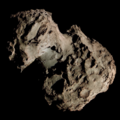C/2001 Q4 (NEAT)
 Comet NEAT and Messier 44 photographed by Oliver Stein on 16 May 2004 | |
| Discovery | |
|---|---|
| Discovered by | NEAT |
| Discovery date | 24 August 2001 |
| Orbital characteristics[1][2] | |
| Epoch | 15 May 2004 (JD 2453140.5) |
| Observation arc | 1,811 days (4.96 years) |
| Number of observations | 2,617 |
| Perihelion | 0.962 AU |
| Eccentricity | 1.00069 (inbound) 1.00067 (outbound) |
| Inclination | 99.643° |
| 210.28° | |
| Argument of periapsis | 1.204° |
| Mean anomaly | –0.000018° |
| Last perihelion | 15 May 2004 |
| Earth MOID | 0.043 AU |
| Jupiter MOID | 4.279 AU |
| Physical characteristics[3] | |
| Dimensions | 3.6–7.2 km (2.2–4.5 mi) |
Mean diameter | 5.4 km (3.4 mi) |
| Comet total magnitude (M1) | 8.0 |
C/2001 Q4 (NEAT) is a comet with an almost perpendicular retrograde orbit which brings it into the inner Solar System by a deeply southward path.[2] It initially emerged from its remote home spending most of its time near the south celestial pole. This comet was discovered on August 24, 2001 by the Near-Earth Asteroid Tracking program (NEAT).
In 2004, residents of the southern hemisphere had the opportunity to watch the comet gradually brighten as it raced toward perihelion. On May 6, 2004 the comet approached within 0.32 AU of the Earth.[2] Beginning in early May, the comet started racing north and burst into view in the northern hemisphere when it had reached almost maximum brightness.
With a near perihelion orbital eccentricity of 1.00069 (epoch 2004-May-18)[2] that keeps a barycentric epoch 2014-Jan-01 eccentricity of 1.00067,[1] this hyperbolic comet is going to be ejected from the Solar System.
Gallery
[edit]-
C/2001 Q4 (NEAT) next to Messier 44 on 15 May 2004
-
The comet on 7 May 2004 by Kitt Peak National Observatory
References
[edit]- ^ a b Horizons output. "Barycentric Osculating Orbital Elements for Comet C/2001 Q4 (NEAT)". Retrieved 10 March 2011. (Solution using the Solar System Barycenter and barycentric coordinates. Select Ephemeris Type:Elements and Center:@0)
- ^ a b c d "C/2001 Q4 (NEAT) – JPL Small-Body Database Lookup". ssd.jpl.nasa.gov. Jet Propulsion Laboratory. Retrieved 11 March 2011.
- ^ D. C. Jewitt (2022). "Destruction of Long-period Comets". Astronomical Journal. 164 (4): 158–166. arXiv:2208.04469. Bibcode:2022AJ....164..158J. doi:10.3847/1538-3881/ac886d.
External links
[edit]- C/2001 Q4 at the JPL Small-Body Database




